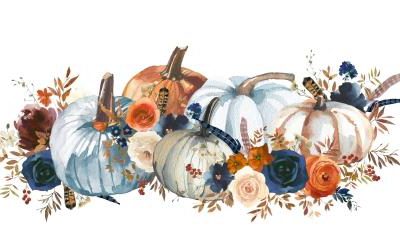
We mark Samhain Festival of Halloween each year on the 31st of October.
Celtic Origins
Halloween’s origins can be traced back to the Celtic festival of Samhain (pronounced Sah-wen). The Celts celebrated their New Year on November 1st, and this day marked the end of the Summer and the harvest. Ahead lay the Winter’s cold and darkness, and the very real prospect of human death in the difficult Winter months.
The Celts believed that on the night before the New Year the veil between the worlds of the living and the dead became thin, and the ghosts of the dead returned to Earth. These ghosts were thought to be troublesome and able to damage crops. To avoid being recognised by the ghosts the Celts wore costumes typically consisting of animal heads and skins. They also believed that in the presence of these Spirits it became easier for their priests, the Druids, to make predictions about the future. Completely reliant upon the natural world as they were, these prophesies offered the people some much-needed comfort through the long, dark Winter.
Druids & Samhain
The Druids built huge, sacred bonfires to celebrate the event of Samhain, and to protect their food stocks the Celtic population carved jack-o-lanterns, placing fire to imitate the sun inside a hollowed-out vegetable, in the hope that the good magic of the sun would preserve their harvested food through the dark months of the year until the next season’s crops could replenish their dwindling stocks of food. This is just one of the rituals that we have adopted from these ancient celebrations, as we encourage our children to carve pumpkins into faces and light the night with the glow of candles placed inside the pumpkin “heads”. The practice of “trick or treating” also seems to have its origins in the Celtic custom of offering small tokens of the harvest to the passing spirits to prevent them causing trouble to the home or the food stored for the Winter.
When the celebrations were over, the people lit the fires in their hearths, which they had extinguished the night before, with the embers of the sacred fires. They hoped that this would keep the fires burning and lend them protection.
The Roman Influence
The Roman Empire had conquered most of the territory previously belonging to the Celts by A.D.43, and in the 400 years or so that they ruled the Celtic lands two Roman Festivals became combined with the traditional Celtic celebrations for Samhain.
The first one was Feralia, the day in late October when the Romans commemorated the passing of their dead; the second was the festival to honour the Roman Goddess of fruit and trees, Pomona. Her symbol was the apple, and it is likely that the incorporation of the festival of Pomona into Samhain explains the tradition of apple bobbing which we practice today on Halloween.
The Christian Tradition
Once Christianity became established, the time when the hard work of the harvest was completed became a time of fun and games for the workers. Unmarried young men would parade the town and call at the houses to beg for gifts for the spirits. In Scotland, the young men dressed up in disguises to indulge in pranks to let off steam and were known as “Guisers” (pronounced “Geezers”), thus beginning the modern tradition of wearing Halloween costumes.
Unmarried girls would use the peeled skin of an apple to see the initial of the man they would marry, if the skin was peeled in an unbroken spiral and cast over the shoulder, the letter it formed when it landed on the ground was supposed to indicate the initial of the lucky man!
All Saints Day
In A.D.609 on May 13th Pope Boniface IV established the Catholic feast of All Martyrs Day in Rome, and later it was expanded by Pope Gregory III to include all saints as well as martyrs. He moved the date on which this was observed to November 1st, and it is widely believed that this was a deliberate attempt to replace the old Celtic festival of the dead with a church-sanctioned holiday.
All Soul’s Day was celebrated in a similar way to Samhain with big bonfires and parades of people dressing up as saints, angels and devils. The celebration was also known as All-Hallows, or All-Hallowmas from the Middle English meaning All Saints Day, and so the night before it became known as All-Hallow’s Eve and, eventually, Halloween.
Modern Times
Whether eating a sticky toffee apple, trick or treating, or carving a pumpkin to illuminate the windows, the things we do on this special night have their origins in the distant past.
Nowadays, our diverse spirituality enables us to pick and choose from the old traditions and add whatever practices are in line with our personal path.
You might enjoy some quiet time in meditation, perhaps lighting a candle to remember the loved ones who are no longer with you and to honour the ancestors, or just bring some foliage and berries into the house to mark the changing seasons of the year. A drink made with the harvest of apples which are plentiful at this time of year is a tasty way to bring the history of Halloween to life on this special night.
Samhain Festival Apple Punch
Ingredients:
2 litres cloudy apple juice
1 large orange
1 lemon
2cm fresh ginger root, grated.
2 cinnamon sticks
2 whole star anise
1 tsp ground nutmeg
½ tsp all spice
1 tsp cloves
5-6 peppercorns
Method:
Zest the lemon and the orange and cut the fruit into quarters.
Place all ingredients in a large pan, heat gently and simmer for 20 minutes on a low heat.
Sieve to remove the “bits” if you prefer.
Enjoy from a heatproof glass or a mug!
However, you choose to celebrate, I hope you will have a blessed Halloween 2023, and perhaps enjoy making some brand-new traditions of your own!
Posted: 31/10/2023
Related Category: Spiritual Holidays












